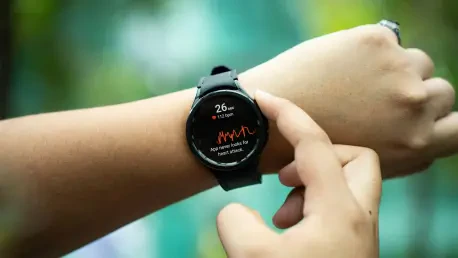The Huawei Watch 5 emerges as a distinctive player in the smartwatch arena, showcasing an impressive blend of cutting-edge design and sophisticated health-tracking applications. This new flagship wearable solidifies Huawei’s commitment to high-quality craftsmanship and technological innovation, ultimately making it a luxury choice for consumers. However, alongside its hardware marvels lies a persistent issue—a limited software ecosystem that challenges its overall market appeal. As the smartwatch landscape continues to evolve, Huawei remains at the forefront of design excellence, yet it confronts a potential obstacle in establishing comprehensive connectivity and app integration that rivals the robust ecosystems of competing brands like Apple and Samsung.
Exceptional Design and Hardware Capabilities
Huawei’s prowess in design shines through in the Watch 5, reinforced by its superior build quality and visually striking features. The smartwatch boasts a vibrant LTPO display that offers unparalleled outdoor readability and contributes to its premium allure. The display excels in brightness, but its automatic brightness settings appear conservative for outdoor conditions, warranting manual adjustments to achieve optimal functionality. Essential hardware advancements emerge through the integration of the new X-Tap sensor, designed to enhance health metric accuracy and improve health data visualization. While innovative, the practical necessity of such advancements raises debate regarding their relevance to user experience, prompting interest yet skepticism among tech enthusiasts and fitness aficionados alike.
Battery life further underpins the Watch 5’s solid hardware reputation, delivering remarkable longevity that alleviates the burden of frequent charging for users. Embracing efficient energy consumption strategies, the smartwatch shines particularly with its always-on display mode. This augments convenience, making everyday usage straightforward and uninterrupted. Huawei’s commitment to innovation is evidenced through its hardware, advancing health technology in the market. Nonetheless, users may debate the necessity of these technological features and their tangible impact on daily use, especially when considering factors such as cost and competition.
Appreciable Health Tracking Features
Huawei impressively extends its domain into sophisticated health tracking in the Watch 5, emphasizing reliable sleep tracking and respiratory monitoring that render accurate, basic health metrics. Concurrently, it finds difficulty translating these metrics into actionable user insights, often presenting them as historical graphs devoid of proactive health coaching. The tangible benefit of such data points lies in their ability to inform and influence conscious lifestyle choices, a facet yet to be optimized in Huawei’s presentation methodology.
Fitness tracking emerges as a standout feature, delivering generally accurate workout stats alongside robust GPS performance that enhances utility for active lifestyles. Notably, however, discrepancies in heart rate accuracy surface, which may deter users seeking precision in these integral metrics. This reveals potential challenges for those prioritizing heart rate accuracy over broader data ranges. Despite such variability, Huawei maintains a commendable foothold in providing broadly reliable health metrics, nurturing an interface that supports user engagement without overwhelming complexity.
Constricted Software Ecosystem
Amidst its hardware and design brilliance, the Huawei Watch 5 struggles to deliver an app ecosystem paralleling leading smartwatches such as those from Apple and Samsung. The smartwatch’s functionality limitations arise primarily from the restricted availability of third-party apps, impacting user engagement and hindering seamless integration with daily activities. Notably, essential services like contactless payment and popular music streaming platforms remain unsupported, isolating the watch from certain functionalities intrinsic to competing smartwatches.
In embracing smartwatch innovation, gesture-based controls and eSIM functionality aim to augment connectivity, but the restricted app ecosystem casts a shadow over these advancements, limiting their potential impact. Although eSIM facilitates phone-free connectivity, the absence of robust app selection undermines the practical appeal of Huawei’s wearable innovations. Addressing this limitation poses a critical challenge as Huawei seeks to capture a broader user base and diversify its integration strategies to rival entrenched tech leaders.
Beyond Hardware and Design Prominence
Huawei’s introduction of hardware developments like the X-Tap sensor demonstrates persistent experimentation in health data enhancement and accuracy. This innovation reflects the company’s drive to advance technological capabilities, although it may not significantly elevate user experience. The choice between Huawei Watch 5 and its competitors often revolves around defining priorities: design versus technological prowess in convenience and app integration. The smartwatch world demands multifaceted functionality, blending aesthetics and utility harmoniously to meet diverse consumer needs.
Huawei’s Watch 5 can appeal strongly to those prioritizing appealing design and battery longevity over comprehensive connectivity. However, tech enthusiasts valuing app diversity or enhanced smart options may gravitate towards alternatives seamlessly integrating connectivity and functionality. As the wearable sector expands, Huawei must navigate its role effectively, excelling in hardware while confronting software limitations. Considerations for overcoming these challenges could ensure broader appeal in establishing a steadfast position amidst formidable competition.
Future Opportunities for Growth
The Huawei Watch 5 stands out in the crowded smartwatch market, being a significant showcase of advanced design fused with top-tier health-tracking capabilities. As Huawei’s latest flagship wearable, it reinforces their dedication to superior craftsmanship and cutting-edge technology, positioning itself as a luxurious option for discerning customers. Despite these hardware achievements, it faces a notable challenge—a constrained software ecosystem that limits its broad appeal to users. As technology progresses, Huawei consistently leads in design innovation, but they face the ongoing task of ensuring seamless connectivity and app compatibility to match the robust frameworks offered by competitors such as Apple and Samsung. This gap in software offerings can affect user experience, as those rivals boast expansive ecosystems filled with third-party apps that complement their devices very well. For Huawei to fully capitalize on its design and hardware strengths, it must address its software concerns to enhance overall user satisfaction, potentially expanding its market share in the competitive smartwatch landscape. By overcoming these hurdles, Huawei could provide a more comprehensive experience that aligns with the high standards set by industry leaders.









